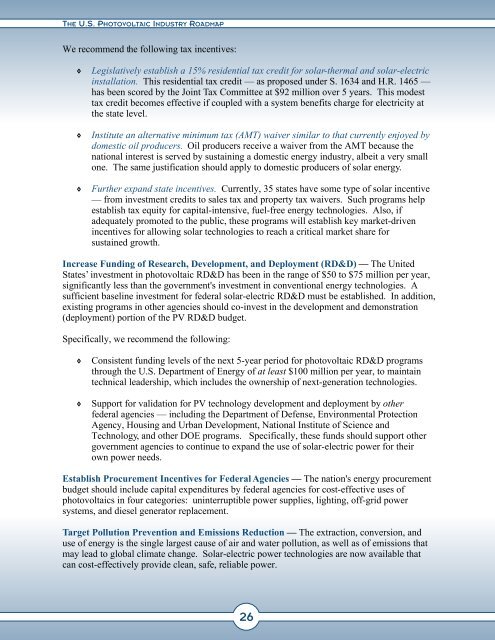Solar Electric Power -- The U.S. Photovoltaic Industry ... - Ecotopia
Solar Electric Power -- The U.S. Photovoltaic Industry ... - Ecotopia
Solar Electric Power -- The U.S. Photovoltaic Industry ... - Ecotopia
Create successful ePaper yourself
Turn your PDF publications into a flip-book with our unique Google optimized e-Paper software.
THE U.S. PHOTOVOLTAIC INDUSTRY ROADMAP<br />
We recommend the following tax incentives:<br />
�<br />
�<br />
Legislatively establish a 15% residential tax credit for solar-thermal and solar-electric<br />
installation. This residential tax credit — as proposed under S. 1634 and H.R. 1465 —<br />
has been scored by the Joint Tax Committee at $92 million over 5 years. This modest<br />
tax credit becomes effective if coupled with a system benefits charge for electricity at<br />
the state level.<br />
Institute an alternative minimum tax (AMT) waiver similar to that currently enjoyed by<br />
domestic oil producers. Oil producers receive a waiver from the AMT because the<br />
national interest is served by sustaining a domestic energy industry, albeit a very small<br />
one. <strong>The</strong> same justification should apply to domestic producers of solar energy.<br />
� Further expand state incentives. Currently, 35 states have some type of solar incentive<br />
— from investment credits to sales tax and property tax waivers. Such programs help<br />
establish tax equity for capital-intensive, fuel-free energy technologies. Also, if<br />
adequately promoted to the public, these programs will establish key market-driven<br />
incentives for allowing solar technologies to reach a critical market share for<br />
sustained growth.<br />
Increase Funding of Research, Development, and Deployment (RD&D) — <strong>The</strong> United<br />
States’ investment in photovoltaic RD&D has been in the range of $50 to $75 million per year,<br />
significantly less than the government's investment in conventional energy technologies. A<br />
sufficient baseline investment for federal solar-electric RD&D must be established. In addition,<br />
existing programs in other agencies should co-invest in the development and demonstration<br />
(deployment) portion of the PV RD&D budget.<br />
Specifically, we recommend the following:<br />
� Consistent funding levels of the next 5-year period for photovoltaic RD&D programs<br />
through the U.S. Department of Energy of at least $100 million per year, to maintain<br />
technical leadership, which includes the ownership of next-generation technologies.<br />
� Support for validation for PV technology development and deployment by other<br />
federal agencies — including the Department of Defense, Environmental Protection<br />
Agency, Housing and Urban Development, National Institute of Science and<br />
Technology, and other DOE programs. Specifically, these funds should support other<br />
government agencies to continue to expand the use of solar-electric power for their<br />
own power needs.<br />
Establish Procurement Incentives for Federal Agencies — <strong>The</strong> nation's energy procurement<br />
budget should include capital expenditures by federal agencies for cost-effective uses of<br />
photovoltaics in four categories: uninterruptible power supplies, lighting, off-grid power<br />
systems, and diesel generator replacement.<br />
Target Pollution Prevention and Emissions Reduction — <strong>The</strong> extraction, conversion, and<br />
use of energy is the single largest cause of air and water pollution, as well as of emissions that<br />
may lead to global climate change. <strong>Solar</strong>-electric power technologies are now available that<br />
can cost-effectively provide clean, safe, reliable power.<br />
26


